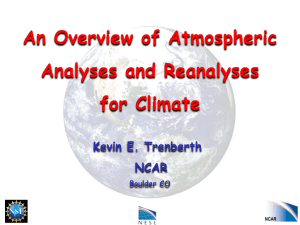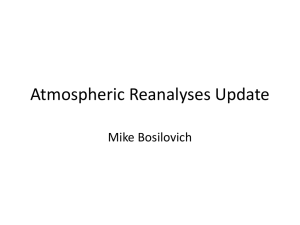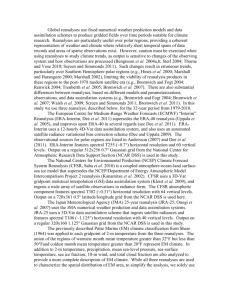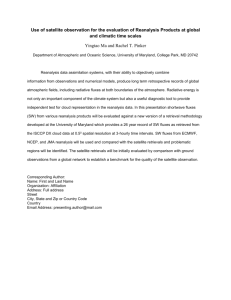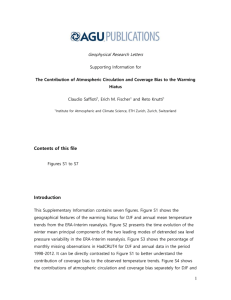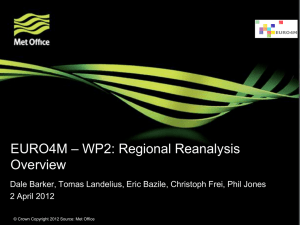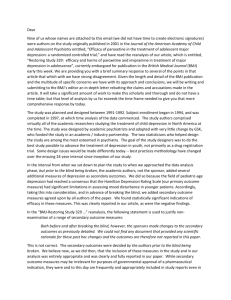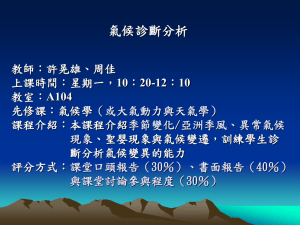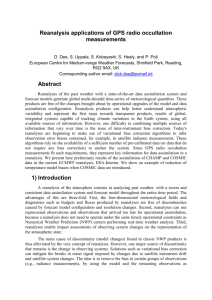WDAC Reanalysis task team
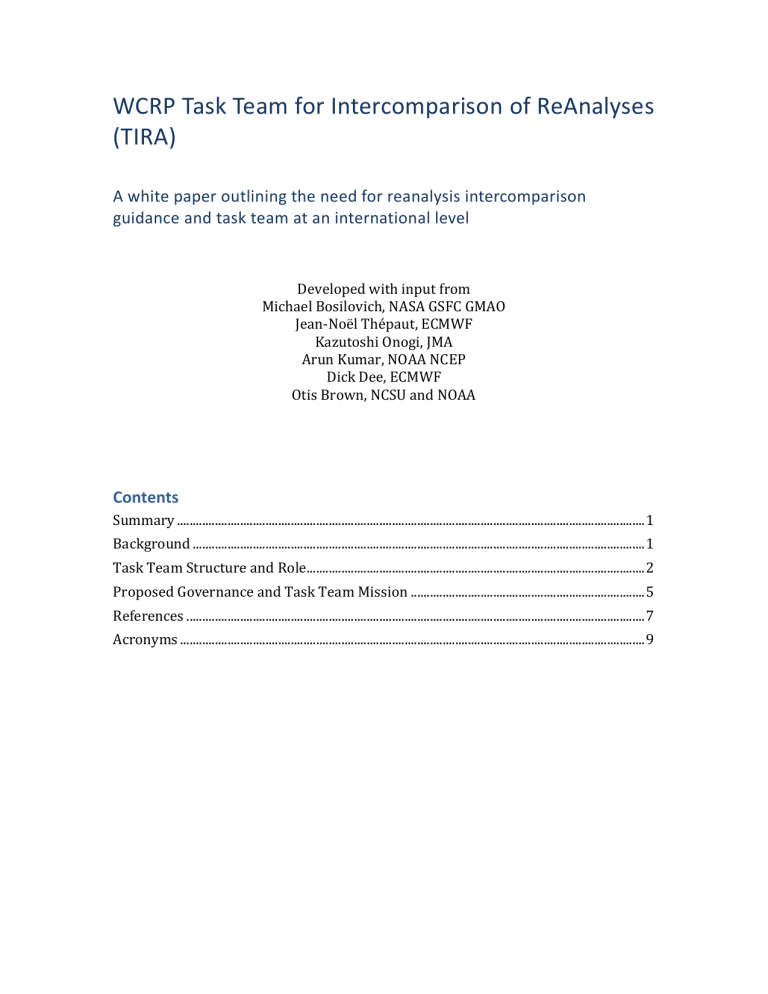
WCRP Task Team for Intercomparison of ReAnalyses
(TIRA)
A white paper outlining the need for reanalysis intercomparison guidance and task team at an international level
Developed with input from
Michael Bosilovich, NASA GSFC GMAO
Jean-Noël Thépaut, ECMWF
Kazutoshi Onogi, JMA
Arun Kumar, NOAA NCEP
Dick Dee, ECMWF
Otis Brown, NCSU and NOAA
Contents
Summary .................................................................................................................................................... 1
Background ............................................................................................................................................... 1
Task Team Structure and Role........................................................................................................... 2
Proposed Governance and Task Team Mission .......................................................................... 5
References ................................................................................................................................................. 7
Acronyms ................................................................................................................................................... 9
Summary
Reanalyses have proven to be an important resource for weather and climate related research, as well as societal applications at large. Several centers have emerged to produce new atmospheric reanalyses in various forms every few years.
In addition, land and ocean communities are producing disciplinary uncoupled reanalyses. Current research and development in reanalysis is directed at (1) extending the length of reanalyzed period and (2) use of coupled models for climate reanalysis. While WCRP’s involvement in the reanalyses communities through the
WDAC 1 (and previously through WOAP) has been substantial, for example in organizing international conferences on reanalyses, a central team of reanalyses expertise is not in place in the WCRP structure. The differences among reanalyses and their inherent uncertainties are some of the most important questions for both users and developers of reanalyses. Therefore, a collaborative effort to systematically assess and intercompare reanalyses would be a logical progression that fills the needs of the community and contributes to the WCRP mission. This white paper outlines the need for a task team on reanalyses and their intercomparison, and the near term objectives of the team.
Background
One of the most frequent questions asked about reanalyses is “Which reanalysis is most appropriate for my project?”. This is an appropriate question to ask, because there is uncertainty in any given reanalysis and the multitude of reanalyses gives a researcher many options to choose from. It is also a difficult question to answer, because the uncertainties in models and observations are rarely well understood. Useful answers to the question, therefore, are often not readily available; especially if the particular event or process has not been studied in depth or if new
Reanalyses
The word “reanalyses” here is used as a general term for all disciplines of reanalysis including atmosphere, ocean, land or other physical system. When specificity is needed, the physical system will precede “reanalysis”. However, historical development of reanalysis data in this sense has been predominantly found in atmospheric reanalyses. In short, a reanalysis is a retrospective analysis using a data assimilation system and forecast model resulting in analyzed field of the observed state and ancillary model derived output diagnostics.
The fundamental characteristics of the reanalysis of data and differences from weather analysis is discussed by Bengtsson and Shukla
(1988) and Trenberth and Olson (1988). A recent status of reanalyses is discussed by
Bosilovich et al. (2013).
1 WCRP Data Advisory Council – See the Acronym Appendix for other definitions.
1
reanalyses have recently emerged. The multitude of available reanalyses, however, allows for intercomparison among the reanalyses and observation data, which is the most obvious method to develop a quantitative estimation of uncertainties inherent to reanalyses (NRC, 2008).
WCRP panels rely on reanalyses for varying data types that are not well observed, if at all. While reanalyses have improved in time, uncertainties remain, and further progress and direction is needed to attain reanalyses data that are reliable to address some critical climate questions (e.g. detection of climate trends). To achieve such progress it is critically important to make clear statements about the limitations of existing reanalyses, about the reasons for those limitations, and about the potential for improvement. Climate models and modeling approaches have benefitted from organized intercomparison activities (such as AMIP and CMIP), but an analogous activity for reanalyses has not been developed. With at least 4 international centers committed to ongoing atmospheric reanalyses development and production (and a multitude of ocean and land reanalyses systems producing data), the reanalysis community will benefit from an institutional organization that includes the developing centers and research community.
While much the same sets of observations are available to all current reanalysis systems (though some methodologies call for limited observing systems), variations can occur in the actual usage of data due to the assimilation method, the way observations are selected, handled and quality controlled, and biases in various properties of the assimilating model. Each of these elements affects uncertainty in any given reanalysis, which is manifested in different ways and is difficult to quantify (CORE-CLIMAX, 2014). Nonetheless, uncertainty information, in a variety of forms, is demanded by the climate data user community (Ferraro et al. 2014).
Careful intercomparison of reanalyses data can contribute to a useful quantitative description of the uncertainties, and more advanced diagnostics of the assimilation can provide valuable information on the information content and quality of the assimilated observations.
While experienced users generally appreciate the complexities and uncertainties that exist in reanalysis data, new users, either new investigators or interdisciplinary users (e.g. the energy industry) often do not. All users will ultimately benefit from certain guidance and structure for the intercomparison of reanalyses. Given the importance of reanalyses in scientific and societal applications and the need for information about their uncertainties, the WCRP should establish a task team on reanalysis and their intercomparison.
Task Team Structure and Role
In 2010, NASA’s Global Modeling and Assimilation Office hosted a Reanalysis
Technical Developers’ Workshop including the atmospheric reanalysis development
2
centers (NCEP, ECMWF and JMA; Rienecker et al. 2012). The motivation for the workshop resulted primarily from the interannual variation of the reanalyses that comes from observing system changes, and how it manifests in each of the (then) latest reanalyses. However, it was recognized that communications with the user community is a crucial need for all the developers. So that, one of the outcomes from the workshop was the establishment of an online wiki, currently located at reanalyses.org. While this has been primarily sharing the latest information on reanalyses, their intercomparison is discussed throughout the pages. This wiki includes contributions from international interdisciplinary researchers, and receives and answers questions from the user community. This grassroots effort has become a hub of reanalysis information, and includes homepages for U.S. national working groups on reanalyses. The fact that this site continues and flourishes signals a community need for readily available and detailed information on all reanalyses. The development of an international coordination activity on reanalysis intercomparison should also use reanalyses.org as a resource and central information location, and contribute to the site’s information content.
While advanced users have tools to deal with the inconsistencies of data format and structure, other users dealing with large numbers of data sources to compare will benefit from tools and unified data structures. Recently, the Web-based Reanalyses
Intercomparison Tools (WRIT) was developed to provide access to and intercomparison of a multitude of atmospheric reanalyses (Smith et al. 2014). WRIT includes all of the most recent reanalyses, and many of the previous generation’s reanalyses, as well as observational data for comparison. Monthly comparisons can be developed with the browser interface and both the graphical output and data can be retrieved. Further developments are planned for the data holdings and structure
(e.g. frequency) of the data.
Climate model intercomparison has greatly benefitted the standardization of IPCC
CMIP experiments’ data. The Collaborative REAnalysis Technical Environment
(CREATE, a companion project to ana4mips) aims to mirror the CMIP data structures with reanalyses data, and place the data on the Earth System Grid
Federation (ESGF) alongside the CMIP models and observations (obs4mips, Ferraro et al. 2014). The CREATE effort would make reanalyses data more readily comparable to CMIP present-day simulations, as well as more intercomparable among themselves. However, as it stands now, CREATE is more a data engineering exercise, but aims to expand services for both users and developers. Connections between WRIT and CREAT-IP are evolving as thee are clear opportunities for synergy. In order to include more advanced information (e.g. innovations and analysis increments), CREATE will need more involved scientific direction and participation if is to evolve into an intercomparison tool. This is the role the task team should/could play.
Identification of uncertainty in reanalyses is a challenging task (see CORE-CLIMAX,
2014). One way to convey qualitative uncertainty information was put forth by
Kalnay et al (1996) using a simplistic classification scheme based on whether the
3
field is more dependent on the observational analysis or the forecast model. Such a classification scheme may provide some quick guidance, but has limitations in today’s environment. First, it only considered a single reanalysis but not a quantitative assessment of the data or advances in data assimilation and Earth
System analysis. It is not clear that even if revised to present day reanalyses that the
Kalnay classifications will be sufficient for today’s users. A better approach would be to provide examples of reanalysis intercomparisons using the CORE-CLIMAX (2014) strategy as a guide to users in performing their own intercomparison experiments that will more accurately answer their questions of quality. The CORE-CLIMAX intercomparison strategy includes various classes of identifying uncertainty that range from simple to advanced and even expert methods. This project builds upon earlier work by Bates and Privette (2012), which promoted a rigorous approach to assess maturity of climate data records. While this is not as easy to implement as a classification scheme analogous to Kalnay et al. (1996), the user community is or should be advanced enough to integrate these results in their work.
Many WCRP panels and working groups make use of reanalyses data in some capacity. As part of their research studies, they may learn new information about the reanalyses that could be beneficial to the developers and others in the user community. Representation in the task team from the various WCRP panels could provide for a valuable dialog with developers. For example, there are questions about when a reanalysis should be “retired” or no longer a viable tool for certain uses. This task team could provide such guidance for WCRP’s panels, while the panels dig deeper into the data than may be possible at the developing centers.
Ocean and land communities use similar offline techniques to atmospheric reanalyses to develop long-term data sets. While much of the perspective in this white paper is related to atmospheric reanalyses, similarities exist with land and ocean reanalyses as well. It is worth mentioning that intercomparison initiatives exist for some of these applications (Balmaseda et al. 2014, and the articles contained in that Feb 2014 issue of CLIVAR Exchanges; Also CPC Real Time Ocean
Reanalysis Intercomparison 2 ) The initial scope does not explicitly consider these components of the Earth System. However, as the coupling of the Earth System advances, representation of these will be crucial to include in the discussions. We expect this to evolve naturally as coupling the components develops.
The global modeling community has benefitted from the Coupled Model
Intercomparison Project (CMIP). CMIP standards have facilitated the intercomparison of the models, sharing of data within the community and ultimately the understanding of the modeled processes. While different issues face the reanalysis community, CMIP demonstrates a paradigm for community connections in developing complex Earth system models that reanalyses may also be advanced.
Furthermore, the SPARC Reanalysis Intercomparison Project (S-RIP) has begun to address the issues facing a reanalyses intercomparison project, and should be
2 http://www.cpc.ncep.noaa.gov/products/GODAS/multiora_body.html
4
considered when developing a more general reanalysis intercomparison project (S-
RIP, 2014). The CREATE project is developing the accessibility and intercomparability of reanalyses and the CORE CLIMAX report on reanalysis intercomparison formalizes some unique aspects of reanalyses and how to intercompare them (CORE CLIMAX, 2014). These provide some of the fundamental building blocks for a reanalysis intercomparison project. The charge to the Task
Team for Intercomparison of Reanalyses (TIRA) is to establish a reanalysis intercomparison project analogous to the CMIP paradigm and tailored to the unique aspects of the reanalyses.
Proposed Governance and Task Team Mission
In the formation of WDAC and WMAC, the JSC determined that reanalyses primarily falls within the purview of the WDAC, so this activity should report to the WDAC.
WGNE includes representatives of many of the operational centers that produce atmospheric reanalyses and WMAC are involved in model-data comparisons as well as the background model physics, and should be active partners in this effort.
Likewise, the GEWEX Data Assessment Panel has developed protocols for evaluating observed data products and their primary mission is directly related to this group’s efforts. Therefore, we propose that WDAC, WMAC, WGNE, GEWEX and CLIVAR all have some representation in the development of the Task Team for Intercomparison of ReAnalyses, as well as the developing centers, ECMWF, GMAO, JMA and NCEP).
CLiC and SPARC should also be represented at an early stage. Ocean and Land community representatives should be included as the project expands (for example
CLIVAR GSOP).
The primary charge to the TIRA is to develop a reanalysis intercomparison project plan that will attain the following objectives.
1) To foster understanding and estimation of uncertainties in reanalysis data by intercomparison and other means
2) To communicate new developments and best practices among the reanalyses producing centers
3) To enhance the understanding of data and assimilation issues and their impact on uncertainties, leading to improved reanalyses for climate assessment
4) To communicate the strengths and weaknesses of reanalyses, their fitness for purpose, and best practices in the use of reanalysis datasets by the scientific community
The WDAC has developed this white paper expecting for interested parties to consider and express support, and begin to add representatives. With enough support from the reanalyses centers and WCRP programs, this task team can begin developing a reanalysis intercomparison plan that addresses this charge. From this,
5
more intricate projects may be undertaken, such as international collaborative experimentation.
6
References
Balmaseda, M. and co-authors, 2014: The Ocean Reanalyses Intercomparison
Project (ORA-IP). CLIVAR Exchanges No. 64, Vol. 19, No.1, p. 3-7. http://www.clivar.org/sites/default/files/documents/Exchanges64.pdf
Bates, J. J. and J. L.Privette, (2012), A maturity model for assessing the completeness of climate data records, Eos Trans. AGU, 93(44), 441.
Bengtsson L., and J. Shukla, 1988: Integration of space and in situ observations to study global climate change. Bull. Amer. Meteor. Soc., 69(10), 1130–1143.
Bosilovich, M. G., J. Kennedy, D. Dee, R. Allan and A. O’Neill, 2013: On the
Reprocessing and Reanalysis of Observations for Climate, Climate Science for
Serving Society: Research, Modelling and Prediction Priorities. G. R. Asrar and J.
W. Hurrell, Eds. Springer. DOI: 10.1007/978-94-007-6692-1_3.
CORE CLIMAX, 2014: Procedure for comparing reanalyses, and comparing reanalyses to assimilated observations and CDRs. COordinating Earth observation data validation for RE-analysis for CLIMAte ServiceS, Grant agreement No: 313085, Deliverable D5.53, pp 45. http://www.coreclimax.eu/sites/coreclimax.itc.nl/files/documents/Deliverabl es/WP_Reports/Deliverable-D553-CORECLIMAX.pdf
Kalnay, E., M. Kanamitsu, R. Kistler, W. Collins, D. Deaven, L. Gandin, M. Iredell, S.
Saha, G. White, J. Woollen, Y. Zhu, A. Leetmaa, R. Reynolds, M. Chelliah, W.
Ebisuzaki, W. Higgins, J. Janowiak, K. C. Mo, C. Ropelewski, J. Wang, Roy Jenne, and Dennis Joseph, 1996: The NCEP/NCAR 40-Year Reanalysis Project. Bull.
Amer. Meteor. Soc., 77, 437–471. doi: http://dx.doi.org/10.1175/1520-
0477(1996)077<0437:TNYRP>2.0.CO;2
Ferraro, R., D. Waliser, P. Gleckler, K. Taylor and V. Eyring, 2014: Report on the
Obs4MIPs – CMIP6 Planning Meeting Apr 29 – May 1 2014. Washington DC. https://www.earthsystemcog.org/site_media/projects/obs4mips/Obs4MIPs-
CMIP6_Planning_Meeting.pdf
National Research Council. 2008: Review of the U.S. Climate Change Science
Program's Synthesis and Assessment Product 1.3: Reanalyses of Historical
Climate Data for Key Atmospheric Features: Implications for Attribution of
Causes of Observed Change. Washington, DC: The National Academies Press.
Rienecker, M. M., D. Dee, J. Woollen, G. P. Compo, K. Onogi, R. Gelaro, M. G. Bosilovich,
A. da Silva, S. Pawson, S. Schubert, M. Suarez, D. Barker, H. Kamahori, R. Kistler, and S. Saha, 2012. Atmospheric Reanalyses—Recent Progress and
Prospects for the Future. A Report from a Technical Workshop, April
7
2010. NASA Technical Report Series on Global Modeling and Data Assimilation,
NASA TM—2012-104606, Vol. 29, 56 pp. http://gmao.gsfc.nasa.gov/pubs/tm/docs/Rienecker491.pdf
Smith, C. A., G. P. Compo, and D. K. Hooper, 2014: Web-Based Reanalysis
Intercomparison Tools (WRIT) for Analysis and Comparison of Reanalyses and
Other Datasets. Bull. Amer. Meteor. Soc., 95, 1671–1678. doi: http://dx.doi.org/10.1175/BAMS-D-13-00192.1
S-RIP, 2014: Progress Report of the SPARC Reanalysis Intercomparison Project (S-
RIP). http://s-rip.ees.hokudai.ac.jp/index.html
Trenberth K.E., and J.G. Olson, 1988: An evaluation and intercomparison of global analyses from NMC and ECMWF. Bull. Amer. Meteor. Soc., 69, 1047–1057.
8
Acronyms
AMIP Atmospheric Model Intercomparison Project
CORE CLIMAX COordinating Earth observation data validation for RE-analysis for
CMIP
CLIMAte ServiceS
Coupled Model Intercomparison Project
CREATE Collaborative REAnalysis Technical Environment
ECMWF European Centre for Medium-range Weather Forecasting
GDAP GEWEX Data Assessment Panel
GMAO Global Modeling and Assimilation Office
JMA Japan Meteorological Agency
NCEP National Centers for Environmental Prediciton
SPARC Stratosphere-troposphere Processes And their Role in Climate
S-RIP SPARC Reanalysis Intercomparison Project
TIRA Task Team for the Intercomparison of ReAnalyses
WDAC WCRP Data Advisory Council
WGNE Working Group on Numerical Experimentation
WMAC WCRP Modelling Advisory Council
9
